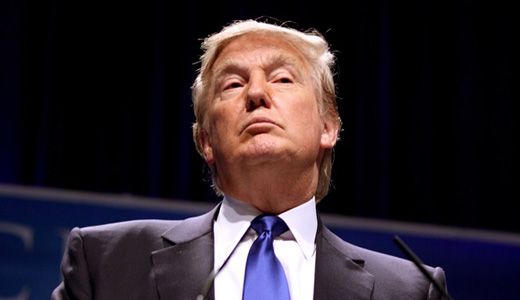
The following story was written by Larry Rubin, C.J. Atkins, and Patrick J. Foote.
CLEVELAND, OHIO – Accepting the presidential nomination of the Republican Party here last night, Donald Trump said, “Nobody knows the system better than me. Which is why I alone can fix it.”
He then stepped back from the microphone to bask in the applause, looking smug and jutting his chin forward, Mussolini style. He made sure the audience could drink in his profile.
It was the last speech on the last day of the Republican National Convention. Trump’s acceptance speech confirmed the worst fears of millions of Americans: his megalomania was front and center as he described how he, “alone,” aided by “the greatest business people in all the world” were going to address the “crisis” facing our nation.
Trump tried to appeal to working people by accurately describing their economic insecurity and accurately pointing the finger of blame at “our nation’s most powerful special interests.
” … these interests have rigged our political and economic system for their exclusive benefit. Believe me. It’s for their benefit.”
He did not mention that he, himself, is one of our nation’s “most powerful special interests” who has made billions by ripping off his workers, exploiting every tax break and loophole imaginable, and by destroying communities to build playgrounds for the super rich.
In his speech, he promised to “outline reforms to add millions of new jobs and trillions in new wealth that can be used to rebuild America.”
He never did, except to say “Decades of record immigration have produced lower wages and higher unemployment for our citizens,” a statement that is not only untrue but racist.
Instead of offering real plans for alleviating the burdens being carried by working people, he tried to encourage their most virulent feelings of nationalism, fear and hate. He presented himself to workers as the strongman who “will be your champion in the White House.”
He was using “dog whistle” rhetoric to specify exactly whose champion he would be. He clearly was reaching out to white folks living in economically depressed areas. Of course, he was excluding just about everyone else – maybe for his own political gain.
Researchers Frey and Ruy Teixeira at the Center for American Progress estimate that even if the anti-Trump minority vote remains as is, he only requires a five point swing among white voters to secure a victory in the electoral college.
Throughout his campaign, Trump has played to the fear of many white workers that the demographic changes taking place in the U.S. will swamp them.
“I am your voice,” Trump thundered. He might as well have said “Make America white again.”
The theme of his speech was “America First,” the slogan used by Nazi sympathizers in the U.S. before World War II.
In other words, Trump gave a speech well suited to an authoritarian demagogue.
The applause was thunderous.
You’d never know that many in the audience had unsuccessfully tried all week to somehow prevent Trump from capturing the nomination. But the entire party eventually fell in line behind him, first the leadership and then the rank and file delegates.
At the beginning of his speech, Trump promised to “present the facts plainly and honestly.”
“We cannot afford to be so politically correct anymore,” he said.
But he did not present “the facts.” He presented a distorted view of the U.S. aimed at eliciting panic.
He painted a dark, almost wholly fictional picture of a nation under siege. He said our country is being destroyed by rising crime, terrorism, and “illegal” homicidal immigrants.
He blamed it all on President Obama.
According to fact checkers at National Public Radio, Trump was playing fast and loose with facts, but that almost goes without saying.
He blamed Hillary Clinton for chaos and war in the Middle East, for the millions of people who have become displaced and are now immigrants, and for the rise in terrorism.
He didn’t specify exactly how Clinton is responsible for all of this, but he did say that if elected president, “We’re going to win [the war against terrorism]. We’re going to win fast.”
He then sunk to repeating his most racist, xenophobic rants:
“We are going to build a great border wall to stop illegal immigration,” he said, “to stop the gangs and the violence, and to stop the drugs from pouring into our communities.”
Furthermore, he said, he would “temporarily” ban immigrants from countries “compromised by terrorism” until they can be “properly vetted.”
“I only want to admit individuals into our country who will support our values and love our people,” he stated. “Anyone who endorses violence, hatred or oppression is not welcome in our country and never ever will be.”
Trump did not explain what he meant by “compromised by terrorism” or properly vetted.”
But after the speech, commentators said they knew exactly what Trump was getting at when he spoke about “building a wall” and denigrated immigrants in general. They said he was signaling the Latino community that he is not interested in their support.
The commentators said Trump was appealing to the worst instincts of white workers who have legitimate grievances and real reasons to be dissatisfied with the government.
They said Trump was trying to pit one group of workers against the other for his own political gain.
Periodically during Trump’s speech the audience encouraged him, not by saying “yes, we can,” but by chanting “yes, you will.”
Millions of Americans are afraid that the audience is correct, that Trump will, in fact, do what he threatens to do: tear the American people apart.
Photo: Channeling Mussolini, Donald Trump receives the adulation of the crowd. | Credit: Gage Skidmore/Flickr












Comments